10 Best Monsoon Treks in Maharashtra That You Should Do In 2024
Maharashtra, a state known for its diverse landscape, offers some of the best monsoon treks in India. From the lush Western Ghats to the mesmerizing Sahyadri Range, there are numerous options to explore the beauty of nature during the rainy season. One such trek is the famous Kalsubai Peak, the highest point in Maharashtra, offering breathtaking views of the surrounding valleys and waterfalls. Another notable trek is Harishchandragad, famous for its ancient caves and the iconic Konkan Kada, a cliff with a sheer drop. For an offbeat experience, trekkers can opt for the Rajmachi trek, where they can witness the cascading Kataldhar waterfall and the historic Rajmachi Fort. Maharashtra’s monsoon treks allow adventure enthusiasts and nature lovers to rejuvenate amidst the picturesque landscapes and rainy ambiance.
The monsoon season in Maharashtra offers a plethora of breathtaking trekking experiences. One of the must-visit destinations is the Kavnai Fort, known for its panoramic views and historical significance. Another noteworthy trek is the Anjaneri Fort, believed to be the birthplace of Lord Hanuman and surrounded by lush greenery. For a challenging adventure, the Rajgad Fort Trek is highly recommended, offering stunning vistas and a glimpse into Maratha history. The Torna Fort Trek is equally captivating, with its rugged terrain and captivating views of the Sahyadri range.
1. Devkund Waterfall Trek
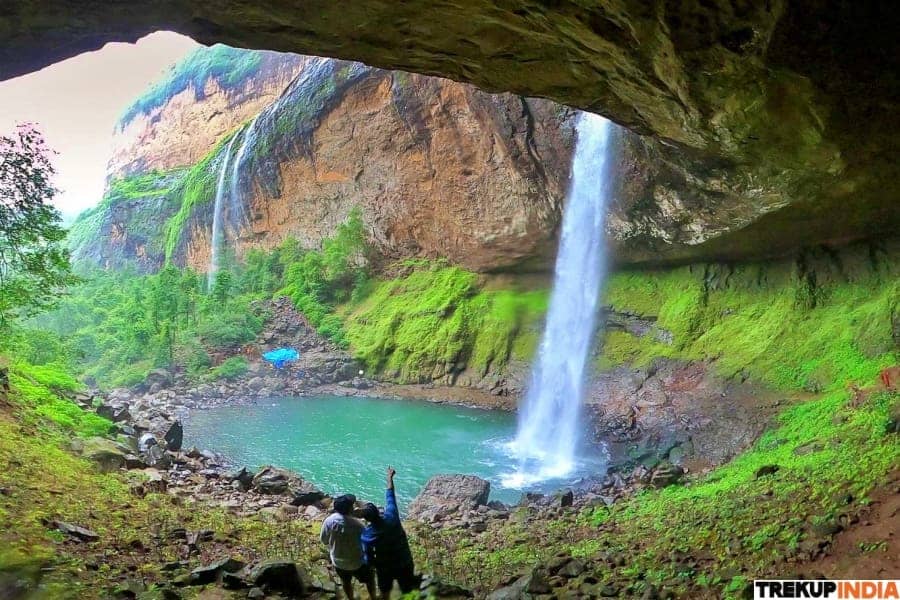
Devkund Waterfall is an attractive natural tourist attraction located in the state of Maharashtra, India. It is recognized for its magnificent appeal and tranquil surroundings, making it a popular destination for nature enthusiasts and trekkers. Devkund Waterfall’s essential qualities and information. Location: Devkund Waterfall is situated near the village of Bhira in the Raigad district of Maharashtra. It is roughly 150 kilometers from Mumbai and Pune. You can take a modest walk in the Tamhini Ghat area to reach the waterfall. While walking, you will go through bountiful environment-friendly forests, uneven ground, and streams that need to be gone across. Height and Characteristics: Devkund is a reasonably tiny waterfall, gauging around 80 feet.
Nevertheless, it is understood for its pristine blue waters, which make it a striking and photogenic natural marvel.
Ideal Time to Visit: The best time to see Devkund Waterfall is during the gale season, which usually drops between June and September. During this time, the waterfall goes to its complete splendor, with a hefty circulation of water cascading the rough cliff.
Trekking Experience: The trek to Devkund Waterfall is a pleasurable experience, with the route going through dense woodlands and supplying breathtaking views of the surrounding hillsides. It’s a relatively easy to modest trek and can take around 3-4 hours, depending upon your pace.
Glamping: For those who want to immerse themselves in the impressive scenery of Devkund, lavish outdoor camping facilities are readily available, offering a distinct possibility to spend a night bordered by nature’s elegance.
Neighborhood Culture: The village of Bhira and the surrounding area use a look right into the local society of rural Maharashtra. Visitors can interact with the local villagers and experience their way of life. The exciting Devkund Waterfall supplies a spectacular backdrop for professional photographers, owing to its lovely environment and the striking colors of the plunging water.
Security Precautions: While seeing Devkund Waterfall, taking safety precautions is essential, especially during the downpour period when the trails can be slippery. Examining the weather conditions and preparing with appropriate equipment for trekking is advisable.
2. Torna Fort Trek
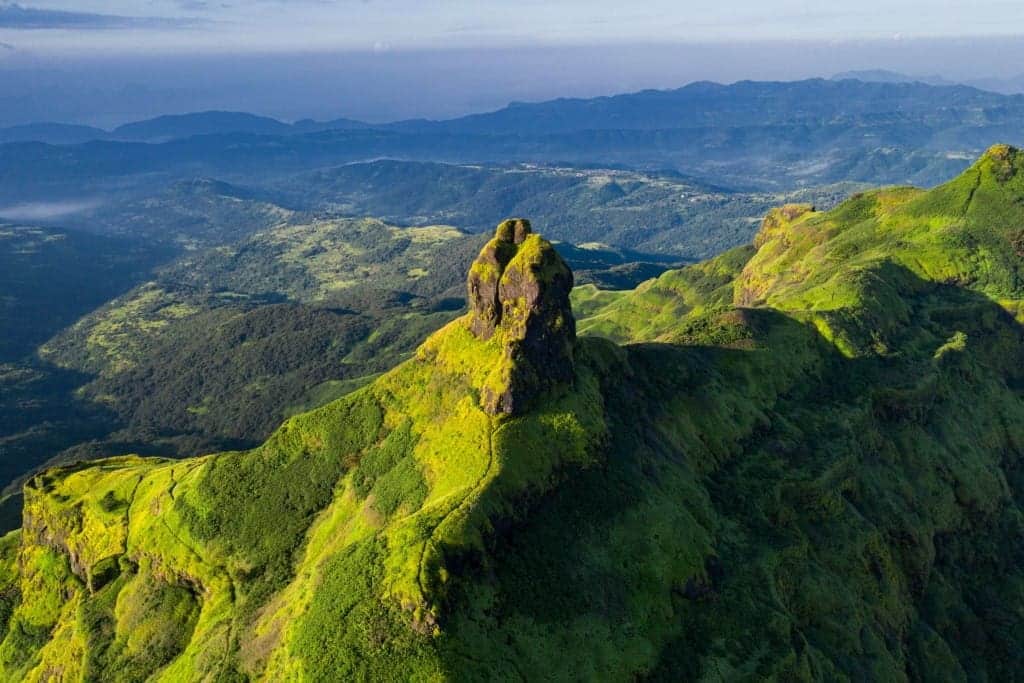
Torna Fort, additionally known as Prachandagad or The Eagle’s Nest is a preferred hill fort located 1400 meters over water level in Sahyadri Mountain Range. It is thought about the highest possible hill-fort in the district of Pune.Torna was the initial fort dominated by Chhatrapati Shivaji Maharaj in 1646 that caused the structure of the Maratha empire. This fort was overcome by Shivaji Maharaj in his teenage years and laid the foundation of the Maratha empire. This makes Torna a special ft for Maharashtrians.
Torna is a well-structured ft. Even today, it is considered a tough ft by trekkers. It stands as one of the most crucial armed forces structures in the history of Maharashtra and the Maratha Empire. The walls and entrances of this ft are in good condition. The wall surfaces are semicircular in shape. One can see the holy places of the fort that are still working, and devotees check out there routinely. The fort is also widely referred to as Prachandagad as a result of its significant property.
The origin of this fort is not known. Nevertheless, the legend claims it was created in the 13th century by Siva Panth who was a follower of the Hindu God Shiva. From 1470 to 1486 A.D., Malik Ahmed, a Bahmani ruler, took control of this fort. In the later times, Nizam shah ruled it. In 1646, Shivaji Maharaj brought this fort under his control from Adilshah, and it pertained to the Maratha Empire. Later on, he named it Torna. He was the one that developed some new frameworks in the ft of Torna. His great escape from Agra is still born in mind in Maratha background.
Shivaji Maharaj came here & restored the ft after he got away from Agra. After Shivaji Maharaj’s death, Mughals took over this fort from Marathas after the murder of Sambhaji Maharaj. However, endure Maratha warriors effectively regained the fort with the critical initiatives of Shankaraji Narayan Sachiv. In 1704 A.D, Aurangzeb once again recorded tje ft Torna and named it “Futulgaib” or “The Divine Victory”. It is also amazing that, within 4 years after the control of Aurangzeb, Sarnobat, NagojiKokate brought this fort under the Maratha Empire. Though Shivaji Maharaj needed to offer several forts in the treaty of Purandar, still Torna remained with him.
3. Bhimashankar Trek
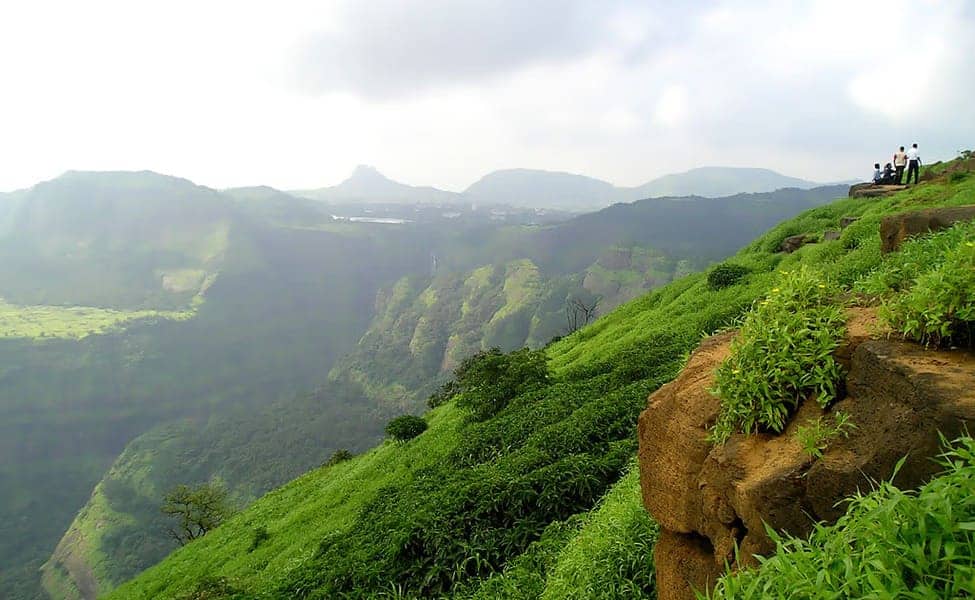
The trail to Bhimashankar is an all-time favorite among trekkers and a lot more so during the monsoons. It takes you right into the heart of Bhimashankar Wildlife haven. While in the forest, you’ll have a range of birds, langurs and identified dear for company. If you’re lucky, you might even reach detect a ‘shekru’ or the Malabar Giant Squirrel. If you’re a first-timer trekking by yourself or with lot of friends who are not extremely seasoned too, we would certainly recommend you avoid the more challenging Shidi Ghat path and take the Ganesh Ghat route instead. The level of trouble varies between easy and moderate, depending on the path chosen. The trail is clearly marked and goes through fields, woodlands, rocks, and includes some sections with ladders. The starting point for the walk is Khandas village, and it is feasible to employ exclusive automobiles or jeeps from Karjat or Neral train stations to reach Khandas.
4. Kalsubai Peak Trek

At an altitude of 1,646 meters or 5,400 feet, Kalsubai Peak is a prominent landmark in Maharashtra, India. Nestled in the Sahyadri mountain range, the height drops within the bounds of the Kalsubai Harishchandragad Wildlife Sanctuary. The top’s powerful height offers an incredible view of the surrounding landscape. Because of its appeal, the trek to Kalsubai Peak has been made much more obtainable by installing steel barriers, chains, and ladders in difficult areas.
5. Harischandragad
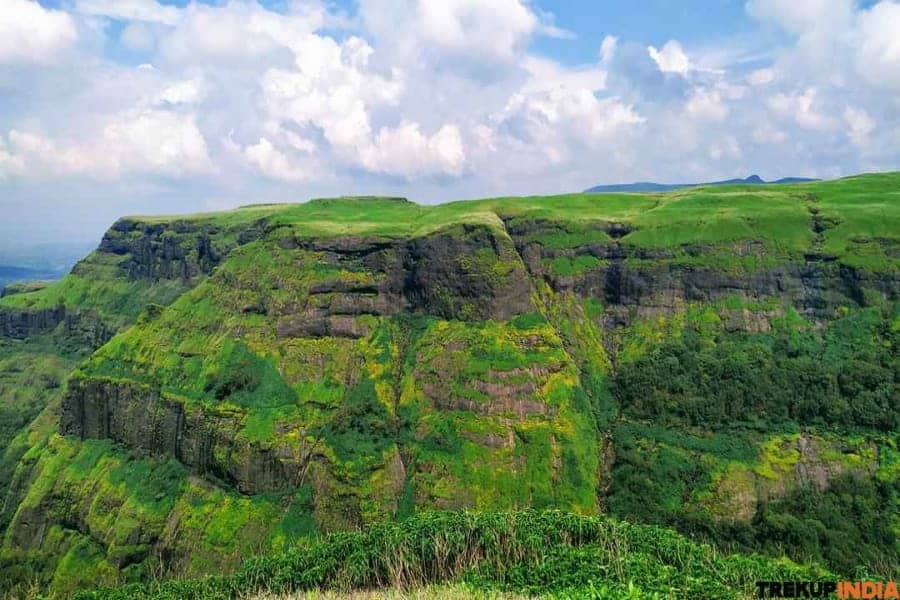
The Harishchandragad trek is a well-liked hiking place in Maharashtra, India’s Ahmednagar area. It is famous for its challenging landscape, bountiful plants, and historical value. Below are some vital realities relating to the trek to Harishchandragad. Place: Harishchandragad is in the Western Ghats of Maharashtra, roughly 200 kilometers from Mumbai. It’s part of the Malshej Ghat area.
Trekking Difficulty: The trek to Harishchandragad is considered modest to complex, depending on the specific course. The trouble level might differ with the period and the trail you take.
Ideal Time to Go: The optimal time to start a journey to Harishchandragad would be while adhering to the gale and throughout the winter, covering from September to February.
The environment throughout this period is agreeable, and the environments are teeming with dynamic foliage.
Trekking Routes: There are numerous routes to arrive at Harishchandragad, each offering a various experience. The most common starting factors are Khireshwar and Pachnai. The Khireshwar path is much more complex, with steep climbs up, while the Pachnai path is less complicated.
Destinations: The Harishchandragad Fort is home to several remarkable tourist attractions, including the ancient Harishchandreshwar Temple, which is devoted to Lord Shiva and is located up. The Kedareshwar Cave, created by an all-natural rock formation, is a distinct place on the plateau and includes a Shiva Linga. The Kokankada cliff supplies spectacular views of the surrounding valleys and the Konkan region. Trekkers commonly camp near the table to invest a night in the wilderness; however, be sure to bring the necessary equipment and obtain authorization if required. In addition, the Taramati Peak is another notable top in the area. Harishchandragad trek can be demanding, and the monsoon period can make it much more arduous. Before starting this experience, guarantee you possess the needed physical conditioning level, have proper trekking outfits and devices, and are knowledgeable about unpredictable weather conditions patterns. The ft holds fantastic cultural and historical value, utilized by numerous empires throughout the ages.
Additionally, it is famously connected to the revered sage Changdev, whose final resting area is within the fort’s facilities.
Transportation: To get to the base village of the trek, you can take a bus or hire an exclusive lorry from nearby towns like Kalyan, Ahmednagar, or Pune. Neighborhood Culture: You may experience local villagers during your trek. It’s vital to appreciate their customs and the setting.
6. Visapur & Lohagad Fort
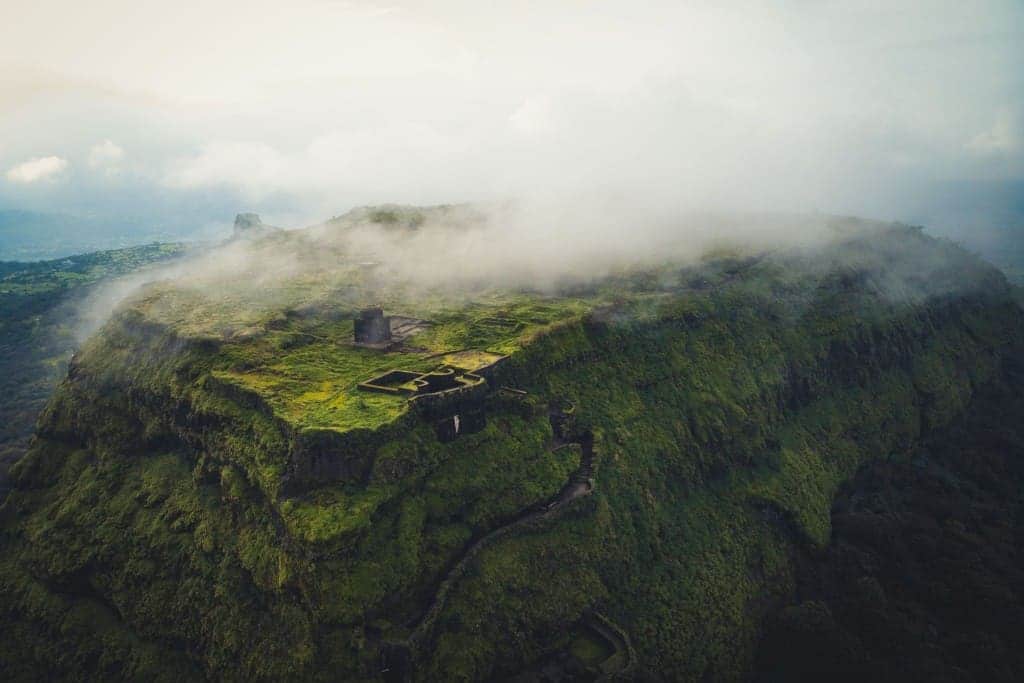
Visapur Fort and Lohagad Fort are 2 historical forts found in the Western Ghats of Maharashtra, India. They are located near the hill terminal of Lonavala and are prominent trekking locations and historic sites. Visapur Fort: Visapur Fort is situated near Lohagad Fort, near Malavali, in the Pune district of Maharashtra. It is approximately 52 kilometers from Pune and around 100 kilometers from Mumbai. The walk to Visapur Fort is classified as moderately testing. The path is usually straightforward, making it an accessible and sought-after trekking location for travelers of different capacities. Visapur Fort flaunts a wide range of historical significance, constructed during the Maratha Empire’s reign. Its tactical layout and critical area made it a helpful possession, with its enforcing bastions and intricate cavern systems being particularly notable functions. Visitors can absorb impressive sights of the surrounding landscape from atop the ft.
Trekking Route: The trek to Visapur Fort generally starts from Malavali, and the trail takes you through lush plants, caves, and old structures. The path is well-marked, making it available for trekkers.
Points of interest: Within the fort, there are numerous remarkable functions to explore, such as the remains of historic structures, a sizable rock archway, the main entryway known as the Visapoor Darwaja, and an age-old temple devoted to the divine being Hanuman. Outdoor camping is a prominent task among visitors visiting the Visapur Fort plateau. It offers a remarkable possibility to value the breathtaking Sahyadri hills, making it a satisfying experience for those participating. Lohagad Fort, a historical wonder, stands pleased in the Sahyadri mountains. Its ancient wall surfaces murmur stories of fights dealt with and won, and its stunning architecture takes you back in time.
Place: Lohagad Fort lies realy near Visapur Fort, in the same area near Lonavala. It is about 95 kilometers from Mumbai and 52 kilometers from Pune.
Level of Difficulty for Trekking: The hike to Lohagad Fort is relatively easy and suitable for both amateurs and seasoned walkers.
The path is specified, and the slope is progressive. The historical relevance of Lohagad Fort is substantial. It has been inhabited by different ruling intrigues, such as the Marathas and the Mughals, for many years. The ft sticks out for its fantastic entry gateways, wide trenches, and intricate architectural format.
Trekking Route: The trek to Lohagad Fort commonly starts from the village of Lohagadwadi. The trek offers panoramas and historical attractions along the way.
Tourist attractions: Key tourist attractions on Lohagad Fort include the Vinchu Kata (Scorpion’s Tail), the Maha Darwaja (primary entrance), the Hanuman Temple, and the many ancient structures that are spread across the ft.
Camping: Like Visapur, Lohagad Fort additionally supplies outdoor camping possibilities, permitting trekkers to experience the fort’s historic setting and beautiful environments.
7. Rajgad Fort
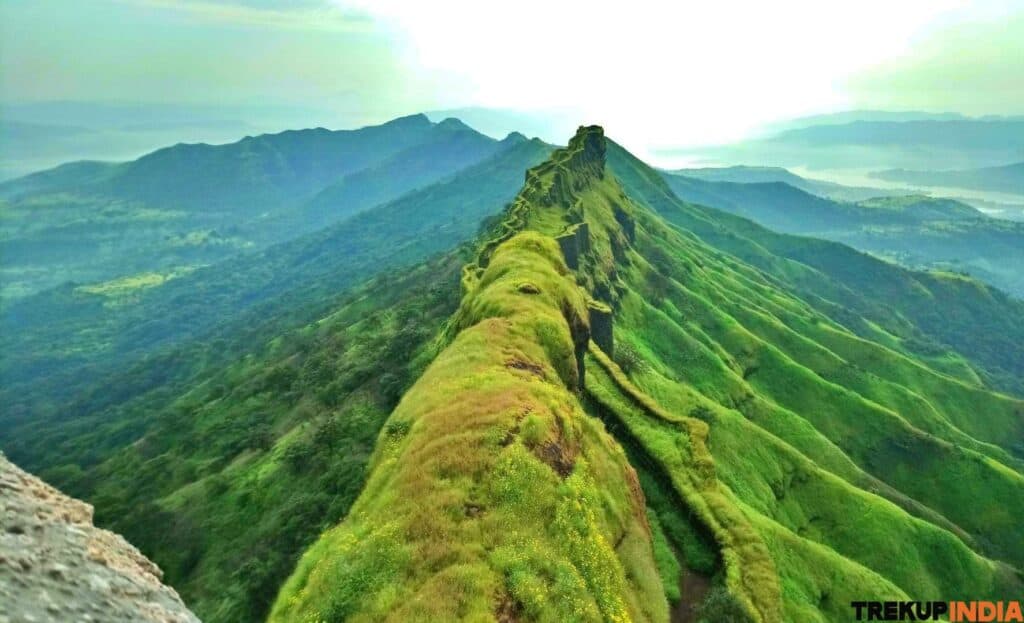
In the Pune district of Maharashtra, India, Rajgad Fort is a traditionally renowned and beloved trekking destination, earning the name “King of Forts” in the Maratha region. This impressive stronghold boasts natural elegance and great social value, making it a must-visit attraction for history enthusiasts and nature lovers. Right here is some essential information concerning the Rajgad Fort trek: Place: Rajgad Fort is situated 40 kilometers southwest of Pune and about 120 kilometers from Mumbai. It’s part of the Sahyadri mountain range in the Western Ghats.
Trekking Difficulty: The trek to Rajgad Fort is moderate to challenging, depending on your specific route and experience. Steep climbs and difficult surfaces define the trek.
Best Time: Rajgad Fort is finest experienced during the post-monsoon and winter seasons, from September to February. The weather conditions agree with this, and the surrounding landscape remains in complete glory during this time.
Trekking Routes: There are several trekking routes to reach Rajgad Fort’s top, each offering a memorable experience. Some of the most typical starting points are Gunjavane, Pali, and Bhor. The Gunjavane path is just one of the more preferred paths, while the Bhor course is known for being much more challenging.
Padmavati Temple: At the top of Rajgad Fort, you’ll find the Padmavati Temple, committed to Goddess Padmavati. It’s a considerable church and historical value.
Suvela Machi and Sanjeevani Machi: These prominent ridges supply spectacular views of the surrounding hills and valleys.
Bale Killa: This is the highest part of the fort, known for its calculated significance throughout fights. It offers breathtaking sights of the entire ft complicated and surrounding locations.
Historic Significance: Rajgad Fort has an abundant history and was a crucial fort during the time of Chhatrapati Shivaji Maharaj. It was the funding of the Maratha Empire for a substantial duration. The ft has remnants of various frameworks, including the remains of the palace, granaries, and water storage tanks.
Camping: Trekking lovers commonly camp at Rajgad Fort, permitting them to experience the fort’s historical atmosphere and all-natural elegance. Guarantee you have the correct camping equipment and needed authorizations if needed. Embarking on this experience can be tricky, especially during the monsoon season when the paths become unsafe. It’s crucial to be in excellent physical shape, equipped with ideal equipment, and vigilant regarding unforeseeable weather conditions. Hire a local guide if you’re unfamiliar with the terrain to ensure a risk-free and effective trek.
8. Prabalgad
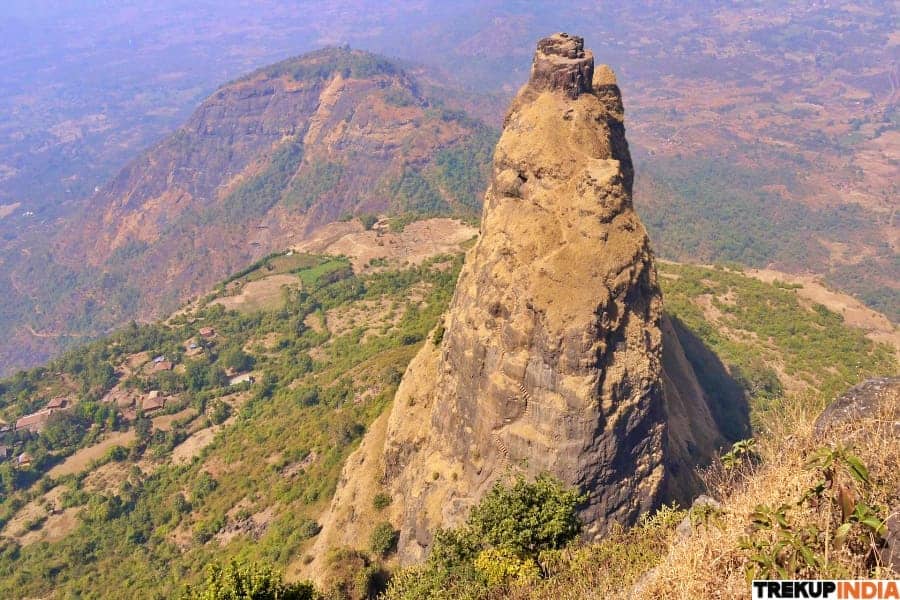
Prabalgad, likewise called Kalavantin Durg, is a historic fort in the Western Ghats of Maharashtra, India. It is a popular trekking destination, understood for its challenging trek and incredible sights. Prabalgad can be located at Prabalmachi village, which is located in Maharashtra’s Raigad district. It is easily positioned at an equal distance of 46 kilometers from Mumbai and Pune.
Trekking Difficulty: The trek to Prabalgad is considered reasonably challenging to challenging. The trek involves high climbs, rocky surfaces, and narrow pathways. It’s a favorite among trekkers that enjoy a little bit of experience.
Best Time to Go: One of the most suitable periods for a Prabalgad trek remains in the months of the monsoon period and throughout the winter season, from September to February. The environment is pleasurable during this timeframe, and the landscapes appear vivid and verdant. There are two courses to reach Prabalgad – the Prabalmachi and Thakurwadi paths. The Prabalmachi path is favored and offers a relatively simpler climb, while the Thakurwadi route is shorter yet steeper and more challenging. Both courses provide fantastic sights of the nearby location.
Must-see views: The Kalavantin Pinnacle is a popular fort function renowned for its towering rock development that walkers can ascend. Although the ascent requires and needs substantial initiative, it rewards climbers with impressive 360-degree panoramas. Prabalgad Fort boasts an abundant history, and its maintained architecture is a testament to its cultural value. The fort’s premises are home to different holy places, caves, and water storage space facilities, making it a fascinating location for those considering the region’s past. When you ascend the initial part of the journey, you will reach the Prabalmachi plateau, a perfect place for setting up camp. This plateau supplies remarkable scenic sights of the neighboring hills and valleys.
Camping: Many trekkers select to center at Prabalmachi, which is a level plateau right before getting to the fort. Camping supplies a chance to experience the region’s natural beauty and take pleasure in a night under the stars.
Safety and precautions must be considered when embarking on the trip to Prabalgad. Specifically, the ascent to the Kalavantin Pinnacle is challenging and not advised for inexperienced climbers. Trekkers need to be in excellent physical condition and equipped with the required gear for trekking.
9. Harihar Fort Trek

Harihar Fort, also called Harshgad, is a historic hill fort in the Nashik area of Maharashtra, India. It is a prominent trekking location recognized for its one-of-a-kind rock-cut actions, testing climb, and stunning breathtaking sights. Below are some vital details about Harihar Fort: Location: Harihar Fort is situated near the village of Nirgudpada, about 48 kilometers from Nashik, Maharashtra. It is approximately 200 kilometers from Mumbai and 180 kilometers from Pune.
– Harihar Fort is a historic fort located in Maharashtra, India.
– It was built during the rule of the Yadava dynasty in the 11th century.
– It is known for its unique architecture and strategic location.
– Harihar Fort offers breathtaking views of the surrounding landscape.
– The fort is a popular tourist attraction often visited by trekkers and history enthusiasts.
Trekking Difficulty: The trek to Harihar Fort is moderately challenging. The fort is understood for its high rock-cut actions, narrow pathways, and difficult climb. It’s a favorite amongst trekkers who delight in adventure and technological climbs.
Best Time to Visit: The best time to trek to Harihar Fort is during the post-monsoon and cold weather, from September to February. The weather is pleasant this time, and the landscape is green and picturesque.
Trekking Route: The trek to Harihar Fort typically starts from the base village of Nirgudpada. The trail includes a steep ascent via rock-cut actions, a challenging traverse along the rock face, and finally reaching the fort’s summit.
Attractions: Rephrased paragraph: Arriving at Harihar Fort awards site visitors spectacular views of the hills, valleys, and surrounding forests. The demanding ascent and the distinct rock steps that guide mountain climbers make the journey much more appealing to journey hunters.
Steep Ascent: The fort’s entrance is noted by a complicated high cliff face, with rock-cut steps that lead up to a breathtaking sight. The climb is not suggested for those weak in heart or lacking confidence. Harihar Fort’s sturdy surface and limited room make camping directly on the fort unusual, but numerous adventurers decide to establish a camp in Nirgudpada or the bordering area instead. This enables them to submerge themselves in the all-natural elegance of the site and prepare for the trek in advance.
10. Manikgad
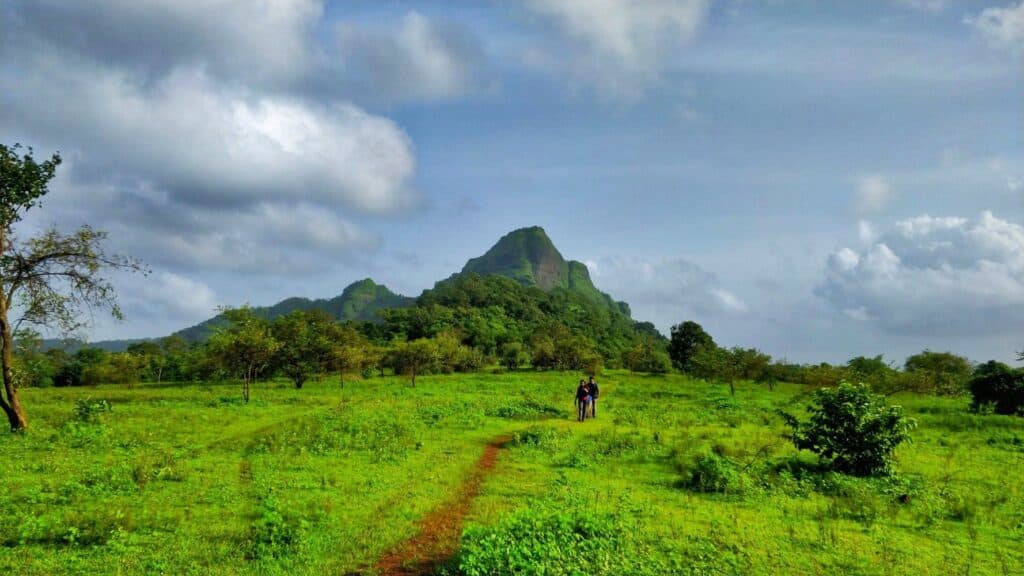
Manikgad, conversely called Manikgarh Fort, is an ancient fort in the Raigad region of Maharashtra, India. Snuggled in the Sahyadri array, it is a popular place for trekking because of its picturesque landscape, rich past, and breathtaking views. Below are some important information concerning Manikgad: Manikgad can be found near the rural area of Maan, which remains in the Raigad area of Maharashtra. It’s around 60 kilometers from Mumbai and about 110 kilometers from Pune. The Manikgad trek provides a happy medium for adventurers of all levels, with a course that’s not also challenging to follow and a climb that’s mild enough for both rookies and veterans.
Perfect Time to Go: The suitable time to start a trek to Manikgad is from September to February, which falls in the post-monsoon and winter seasons. The environment is agreeable, and the surroundings showcase lavish greenery and attractive views. The trip to Manikgad begins at the charming village of Maan, which serves as the base camp for the trek. As you start the trail, you’ll be wrapped up by thick forests that provide an attractive backdrop for your experience. After a few hours of hiking, you’ll reach the top of the fort, where impressive views await.
Must-see sights: Manikgad Fort boasts a rich historical background, showcasing numerous remnants of structures, such as the major entrance, fort walls, and several holy places. The summit of the fort offers awesome 360-degree sights of the bordering hills and valleys. On top, there is a cave facility waiting to be found. The caverns offer a safe house and hold significant historical value. Journey applicants often decide to establish camp at Manikgad, especially at the top of the fort, as it supplies an opportunity to immerse oneself in the picturesque surroundings and relish a night below the starry sky. To ensure a secure and delightful experience, it is important to bring essential camping equipment and follow guidelines for lasting camping practices.
About Author

Preetam Singh Rawat (Founder)
The person behind this trekking organization is someone who’s spent over a decade – 12 years, to be exact – living and breathing the mountains. With multiple high altitude summits under his belt (we’re talking 6000 to 7000 meter peaks), he’s not just experienced – he’s the real deal.
But what really sets him apart is the sheer number of treks he has guided. He has led over 200 Himalayan expeditions, including well known routes like Bali Pass, Buran Ghati, Rupin Pass, Pin Bhabha, Stok Kangri, and Black Peak. Not just once, but multiple times. So yeah, when it comes to the Himalayas, he knows every twist in the trail and every story the mountains have to tell.
Got questions or want to get in touch? Write to Preetam at preetam@trekupindia.com. He’s always happy to chat about treks, answer your questions, or help you prepare for your next big adventure.
Why TrekupIndia?
Since 1993
- Trekup India has been one of the most recommended partners for trekking adventure tourism for more than 29 years. Featuring more than 75 Himalayan treks makes us supreme in the domain.
- We have explored trails like Kedarkantha Trek, Rupin Pass Trek, Borasu pass, Bali Pass, etc.
- Trekup India is India’s Oldest, Safest And direct operation trekking organisation. Trekup India has more trekkers than any other organization. 15,000 plus for 2022
We Are Approved And Certified By :-
- Adventure Tour Operators Association of India (ATOAI)
- Indian Mountaineering Foundation (IMF)
- State Tourism Department
What We Do?
- Trekup India is the most trusted trekking company in India. We also sets safety standards for the entire trekking industry.
- Trekup India is the pioneer of trekking in India. Trekup India has brought most trekking routes, trekking systems and trekking equipment to India for Indian trekking.
Save The Trail
- Trekup India’s Save The Trails program is a favorite among trekkers. Our Save The Trails program has made trails, where Trekup India runs trekking, pristine. Save The Trails is a great way for trekkers to leave our mountains better that we found them.
- Trekup India is a unique trekking company that offers the Trekup India’s Trekkers best experience. These transformative experiences are well-designed and leave an indelible impression on trekkers. These have been around for 29 years.

